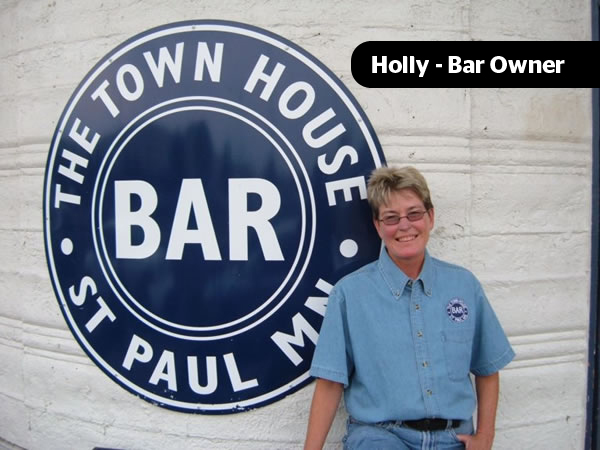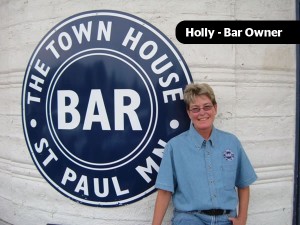
 With roots that go back to 1949, The Town House is St. Paul’s oldest LGBTQ bar and everyone knows it. Everyone but local historians consulting on the Central Corridor Light Rail project, who have suggested that the bar is an ineligible contender for the National Register of Historic Places. Without the Register’s protection, the Town House could very well fall to the wreckers in an effort to attract ‘family friendly’ businesses to University Avenue’s fancy new train in 2014.
With roots that go back to 1949, The Town House is St. Paul’s oldest LGBTQ bar and everyone knows it. Everyone but local historians consulting on the Central Corridor Light Rail project, who have suggested that the bar is an ineligible contender for the National Register of Historic Places. Without the Register’s protection, the Town House could very well fall to the wreckers in an effort to attract ‘family friendly’ businesses to University Avenue’s fancy new train in 2014.
Built as University Cleaners and Dryers in 1924, the building at 1415 University Avenue became The Tip Top Tap in 1941, and underwent an extensive remodeling in 1946. A local interior designer named Werner Wittkamp transformed the bar into a jazzy juke joint with a swirling ceiling and late Art Deco furnishings. The Tip Top Tap didn’t last long (1941-1948), and became The Town House in 1949. After losing business along with the rest of University Avenue in the 1960s, the Town House’s owners gave the ailing establishment to their accountant, Emmett Jewel, in return for services that they could not pay for outright.[i]
Perhaps a “straight” bar since the late 1940s, perhaps not, the Town House went bankrupt within months of the ownership change, but Jewel’s fortunes turned when he changed 1415 University into one of St. Paul’s only gay establishments in 1969.[ii] The quick change went unpublicized, and many regulars of the Town House returned to their haunt only to find a surprise.
“I remember when the Town House first opened,” Connie Harlan told queer historian Anne Enke. “Before it was a gay bar, a lot of ladies who had been shopping at [Montgomery] Ward’s would come over—it was a nice little restaurant and they’d come over for lunch or in the late afternoon. Oh! And when it switched to a gay bar ha ha ha! Oh that was a riot! We’d watch them come in, watch them take it all in!”[iii]
Enke notes that the newly-gay Town House initially catered to a male clientele, “but women showed up there in numbers unseen at any previous bar with the exception of Honey’s.”[iv] Established in the late 1950s, Honey’s was the first of Eleanor “Honey” Harrold’s many ventures, but arson leveled the suburban bar in 1969 and women went in search of a new haunt—The Town House.
Women regulars claimed the Town House as the “women’s bar,” and so agitated certain gay men and the bar’s managers that the “women’s area” began to mysteriously lose its furnishings. Finding a cigarette machine occupying their former space in the early months of 1974, the women staged a sit-in on the dance floor and refused to get up. Managers called in St. Paul’s finest to forcibly remove female (but not male) sitters, and this prompted a public picket outside of the bar for weeks. The women finally challenged the Town House in court, citing St. Paul’s newly-established human rights ordinance (the same ordinance that Anita Bryant helped overturn in 1978) and they won their case.
“To draw such attention to a gay bar was unprecedented;” Enke noted, “lesbian patrons and their male supporters had never demanded rights from a gay bar—and from the city—in so public a fashion.”[v]
After women forced Jewel to rectify his issues with queer women, he gave management of the Town House to his daughter, Kelly Jewel, and hired Honey Harrold as co-manager. The Town House became a successful convergence of men and women and, after a Western stint in the 1990s,[vi] it comfortably settled into its hard-won status as “St. Paul’s oldest GLBT bar.”
Though valued as a historic cornerstone by LGBTQ patrons and queer historians alike, local historians are unaware of the Town House’s queer past, beyond noting that is it “presently a gay bar.” Hess, Roise, and Company, a historical consultant hired in preparation for the Central Corridor light rail line, noted that 1415 University is one of the avenue’s primary exhibitors of the “Streamline Moderne” style. But the firm dismissed the structure as ineligible for the National Register of Historic Places (see pages 105-106) because it “does not appear to be particularly significant,” asserting that “the altered interior does not contribute to the history of the building.”[viii] Rephrased, their statement suggests that the remodeler—the Town House—has robbed the building of its historic integrity instead of contributing to it.
Another report in 2007 suggested tearing the whole thing down (see page 11)–despite the Town House’s desire to stay at the site–and replace it with “family friendly” ventures, such as coffee shops, restaurants, and a day care center. The report did outline one option to rebuild the bar and add patio seating, but a map of the three-block development area includes the Town House as part of the possible demolition zone. If demolition is in the works, it will likely happen only after Central Corridor is finished—provided that the Town House can survive several years of street construction, and permanent loss of 90% of its street parking.
In my opinion, Central Corridor has angered all but its most die-hard supporters because its implementation was poorly planned in respect to minority populations. This isn’t the first time something like this has happened; communities of color remember when the bulldozers obliterated Rondo Avenue—St. Paul’s most diverse commercial artery—in preparation for Interstate 94 in the 1960s. We, too, should remember when the Minneapolis Gateway District fell to the wreckers—in preparation for parking lots and “family-friendly” uses–because it was the incubator of local “vice,” including Minneapolis’ earliest queer bars. History is repeating itself all over again.
How can we stop this ugly paradigm? If the impending demise of Porky’s is any indication, it is in the hands of local government, local preservationists, and the Town House’s ownership. The former must recognize that the Town House is historic, not only because of its interesting architectural past, but also because it is a landmark in the historic development of Minnesota’s LGBTQ population. Referring to the Town House as “presently a gay bar” mislead people into thinking that gay rascals wrested it from historical significance a short time ago. The Town House is 42 years old, and should be considered historic because it is an important queer place. If Frank Kameny’s house is eligible for the National Register, then why isn’t the Town House? Does a queer presence automatically negate historic significance? Are we a recent development?
The Town House’s owners have to weigh their options. They could seek a local historic designation from the City of St. Paul, which would automatically place them in consideration for the national register. If they could afford it, wouldn’t it be cool if they revived the old interior? If they don’t do something now, the future of St. Paul’s oldest queer bar could very well be in jeopardy. A new train is coming, and the queer community might not be on board.
[i] Jean-Nickolaus Tretter. Interview with the author, 2/22/10
[ii] Anne Enke, Finding the Movement: Gender, Sexuality, and Contested Space (Durham, NC: Duke University Press, 2006) 45-46. It is important to note that one cannot ascertain with absolute certainty that the Town House was an exclusive den of heterosexuality before 1969; logically, a queer person or group of persons used the establishment at least once in the two decades prior.
[iii] Ibid. Harlan recalls that the establishment was known as The White House Restaurant before 1969, but city directories affirm that the name never applied to 1415 University.
[iv] Ibid.
[v] Ibid.
[vi] “Bar Hopping,” Twin Cities GAZE, issue 171, 8/21/1992, page 14
[vii] Larry Millet, AIA Guide to the Twin Cities, 501
[viii] Hess, Roise and Company, “Supplemental Historic Property Investigations and Evaluations for the CCLRT Project: Minnesota Milk Company, Tip Top Tap, Quality Park Investment Company: National Register Evaluations,” 105-106
How interesting. The TH and the LR need to join forces. It’s as important and as logical as MPR and LR coming together. They’ll figure it out, right?
My first visit to the townhouse was when a friend showed me to the bar in the 1990’s. I was pleasantly surprised to find the atmosphere bright and lively, rather being a rundown dingey bar with little atmosphere. Instead there was good music in the background, people sat at small tables that might be able to accommodate two or three people, with a few pollinating the conversations by flitting between the tables. I enjoy It, and think it would be a very sad day if it were to be dashed from the landscape.
Comments are closed.